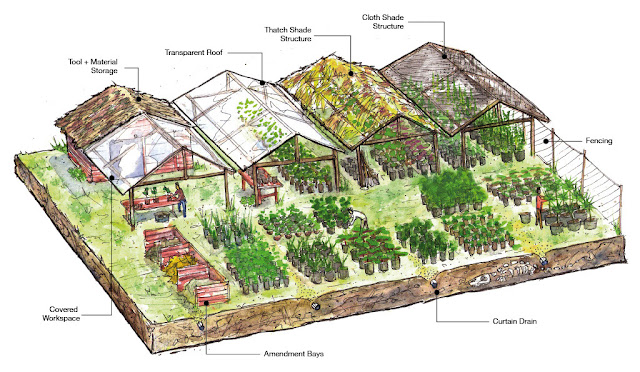Skip to main content
Nursery plants
Nursery plants
A nursery is a place where plants are propagated and grown to usable size. They include retail nurseries which sell to the general public, wholesale nurseries which sell only to businesses such as other nurseries and to commercial gardeners, and private nurseries which supply the needs of institutions or private estates. Some retail and wholesale nurseries sell by mail.
Nurseries may supply plants for gardens, for agriculture, for forestry and for conservation biology.
Some nurseries specialize in one phase of the process: propagation, growing out, or retail sale; or in one type of plant: e.g., groundcovers, shade plants, or rock garden plants. Some produce bulk stock, whether seedlings or grafted, of particular varieties for purposes such as fruit trees for orchards, or timber trees for forestry. Some produce stock seasonally, ready in springtime for export to colder regions where propagation could not have been started so early, or to regions where seasonal pests prevent profitable growing early in the season.
Planting stock
Planting stock, "seedlings, transplants, cuttings, and occasionally wildings, for use in planting out,is nursery stock that has been made ready for outplanting.The amount of seed used in white spruce seedling production and direct seeding varies with method.
A working definition of planting stock quality was accepted at the 1979 IUFRO Workshop on Techniques for Evaluating Planting Stock Quality in New Zealand: "The quality of planting stock is the degree to which that stock realizes the objectives of management (to the end of the rotation or achievement of specified sought benefits) at minimum cost. Quality is fitness for purpose." Clear expression of objectives is therefore prerequisite to any determination of planting stock quality.Not only does performance have to be determined, but performance has to be rated against the objectives of management.Planting stock is produced in order to give effect to the forest policy of the organization.
A distinction needs to be made between "planting stock quality" and "planting stock performance potential" (PSPP). The actual performance of any given batch of outplanted planting stock is determined only in part by the kind and condition, i.e., the intrinsic PSPP, of the planting stock.
The PSPP is impossible to estimate reliably by eye because outward appearance, especially of stock withdrawn from refrigerated storage, can deceive even experienced foresters, who would be offended if their ability were questioned to recognize good planting stock when they saw it. Prior to Wakeley's (1954)demonstration of the importance of the physiological state of planting stock in determining the ability of the stock to perform after outplanting, and to a considerable extent even afterwards, morphological appearance has generally served as the basis for estimating the quality of planting stock. Gradually, however, a realization developed that more was involved. Tucker et al. (1968), for instance, after assessing 10-year survival data from several experimental white spruce plantations in Manitoba noted that "Perhaps the most important point revealed here is that certain lots of transplants performed better than others", even though all transplants were handled and planted with care. The intuitive "stock that looks good must be good" is a persuasive, but potentially dangerous maxim. That greatest of teachers, Bitter Experience, has often enough demonstrated the fallibility of such assessment, even though the corollary "stock that looks bad must be bad" is likely to be well founded. The physiological qualities of planting stock are hidden from the eye and must be revealed by testing. The potential for survival and growth of a batch of planting stock may be estimated from various features, morphological and physiological, of the stock or a sample thereof.
The size and shape and general appearance of a seedling can nevertheless give useful indications of PSPP. In low-stress outplanting situations, and with a minimized handling and lifting-planting cycle, a system based on specification for nursery stock and minimum morphological standards for acceptable seedlings works tolerably well.n certain circumstances, benefits often accrue from the use of large planting stock of highly ranked morphological grades. Length of leading shoot, diameter of stem, volume of root system, shoot:root ratios, and height:diameter ratios have been correlated with performance under specific site and planting conditions. However, the concept that larger is better negates the underlying complexities. Schmidt-Vogt (1980),for instance, found that whereas mortality among large outplants is greater than among small in the year of planting, mortality in subsequent growing seasons is higher among small outplants than among large. Much of the literature on comparative seedling performance is clouded by uncertainty as to whether the s




A nursery is a place where plants are propagated and grown to usable size. They include retail nurseries which sell to the general public,






Comments